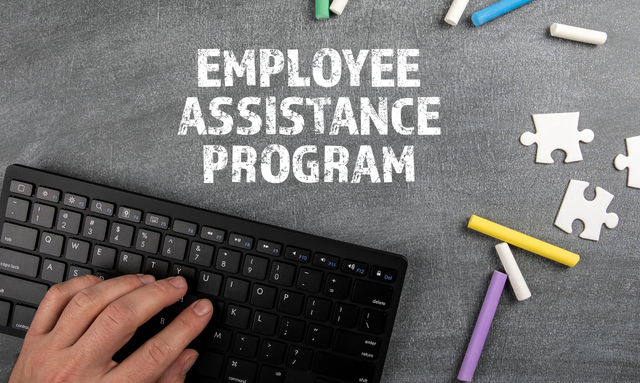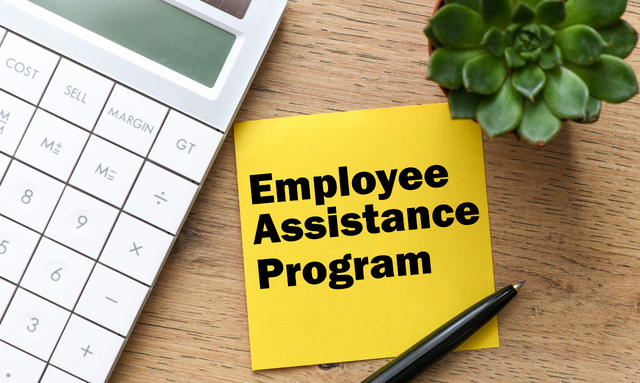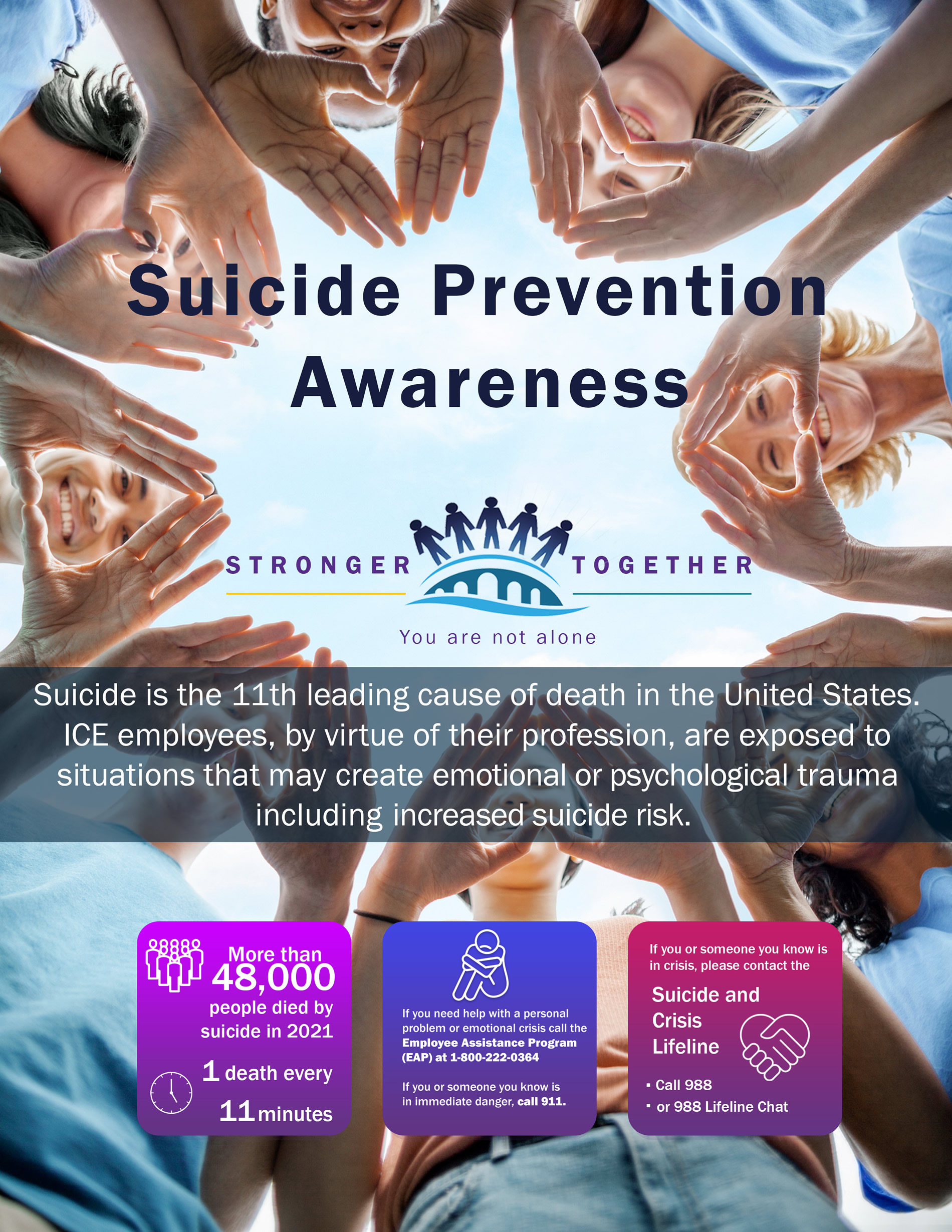
Employee & Family Resources
ICE offers a broad array of benefits programs and family-friendly flexibilities to meet the needs of you and your family. Learn about the resources, benefits and programs available to you that help promote a balanced, healthy approach to life in the workplace and at home.
Do you know what you’re looking for? Click on the appropriate link to be taken directly to the relevant content.
Retirement and Benefits
ICE Retirement and Benefits provides several important services to ICE employees. The team is also responsible for the provision of disability retirement applications, death-in-service to include survivor benefits, and all separations other than retirement. This includes benefits and retirement counseling, processing retirement applications, retirement plan determinations, and preparing retirement annuity estimates. They provide assistance and handle determinations/issues associated with civilian and military deposits, Federal Employee Group Life Insurance (FEGLI) incontestability and reconsideration decisions, Thrift Savings Plan (TSP); Voluntary Leave Transfer (VLTP); Law Enforcement Safety Act certifications; Leave Restoration and Professional Liability Insurance (PLI) eligibility certification. They also administer Federal Employee Health Benefits (FEHB) child equity, spouse equity, and Temporary Continuation of Coverage (TCC). To reach the Retirement and Benefits Unit, please contact OHC-HROCRetirementBenefits2@ice.dhs.gov.
Workers’ Compensation
The Office of Workers' Compensation Programs (OWCP) administers the Federal Employees' Compensation Act (FECA) program that provides wage replacement benefits, medical treatment, vocational rehabilitation and other benefits to federal employees or their dependents who experience work-related injury or occupational disease.
To learn what steps to take, who to contact, and what forms you need if you've been injured on the job, visit the OWCP pages below:
- Federal Employees' Compensation Act FAQ
- Information for Injured Workers and their Representatives
- OWCP Forms
In the event of an on-the-job injury or illness, an employee's first source of assistance is their supervisor. For assistance contacting the appropriate ICE Workers’ Compensation Program point of contact, please call (202) 768-5161.
WorkLife Program
The WorkLife program focuses on maintaining an excellent and engaged workforce by providing the necessary tools to support ICE employees and families across a spectrum of everyday concerns.
-
Who We Are

The WorkLife Program comprises team members who have a passion for the different aspects of employee wellness and are dedicated to motivating ICE’s workforce by providing resources to employees that encourages a healthy work-life balance.
If you have questions or comments regarding work-life balance, please contact us.
-
WorkLife4You

WorkLife4You is an agency-paid benefit designed to help ICE employees and their dependents better manage daily responsibilities and life events. Services include expert guidance from WorkLife specialists, personalized referrals to helpful resources nationwide, and online tools to help.
Related Information: Adult Care & Aging, Career, Childcare & Parenting, Educational Resource, Legal Information, Pets, Travel & Leisure, Financial Information.
Employee Assistance Program (EAP) and Operational Behavioral Health Clinicians
-
EAP Services

ICE offers free and confidential programs that promote and support the health and wellbeing of employees and families. You do not need management approval to use these services. EAP services are always free and confidential.
None of these services are reportable in any background investigation.
-
EAP Benefits

The EAP provides confidential counseling at no cost and referral services that can help you and your family successfully deal with life’s challenges. ICE employees can receive up to six EAP sessions for any one issue/concern in a 12-month period. Eligible family members can also receive EAP services.
Peer Support Program
-
Who We Are

The Peer Support Program was established for those who want a little help but don't know where to turn. Peer Support Members understand and can relate to the demands of the job. Standing on the pillars of Integrity, Confidentiality, and Empathy, they can be a unique bridge for those who would like assistance but may be uncomfortable seeking it through traditional avenues.
-
Peer Support Team Members

Peer Support National Program Managers serve as both the internal and external representatives of ICE’s Peer Support Program, oversee training for Peer Support Members, and organize a national Program response for critical incidents.
Suicide Prevention Program
Don’t Be Afraid to Ask the Hard Question: “Are You Thinking About Suicide?”
Be Aware of the Warning Signs
Talk: Talking (or writing) about wanting to die/ kill oneself, “I wish I were dead;” Expressing hopelessness, pain and feeling like a burden, “Others are better off without me.”
Behavior: Looking for ways to kill oneself; Sending goodbye messages; Giving away valued possessions; Putting affairs in order; Reckless misuse of alcohol, drugs, or weapons.
Take Action to Get Help
High Risk: If the person is at high risk and has already harmed himself or herself, call 911. Do not negotiate with someone who has a gun and get to safety.
Conversation: If the person is not in imminent danger, start a conversation to help them share their concerns, and find out how you might help them. Show care and let them know they are not alone.
Suicide Prevention Toolkit for Veterans in DHS
The Veterans Health Administration, Office of Mental Health and Suicide Prevention has put together a Suicide Prevention Toolkit for Veterans in the Department of Homeland Security. The toolkit provides suicide prevention and wellness resources specifically tailored for Veterans.
- Veterans Crisis Line: The Veterans Crisis Line connects Veterans in crisis and their families and friends with qualified, caring VA responders through a confidential toll-free hotline, online chat, or text. Veterans and their loved ones can call 1-800-273-8255 and Press 1, chat online, or send a text message to 838255 to receive confidential crisis intervention and support 24 hours a day, 7 days a week, 365 days a year.
- Suicide Prevention is Everyone’s Business: A toolkit for Safe Firearm Storage in Your Community. VA released the Safe Firearm Storage Toolkit, which was developed in partnership with the American Foundation for Suicide Prevention (AFSP) and the National Shooting Sports Foundation (NSSF), the trade association for the firearms industry. The toolkit guides communities through the process of building coalitions to raise awareness about safe storage practices.
- Resource Locator: This online resource helps Veterans easily find VA resources in their area including Suicide Prevention Coordinators, crisis centers, VAMCs, outpatient clinics, Veterans Benefits Administration offices, and Vet Centers.
- VA’s Social Media Safety Toolkit: Equips Veterans, their families, and their friends with the knowledge needed to respond to social media posts that indicate a Veteran may be having thoughts of suicide. Download the social media safety toolkit for free.
- Reducing Firearm & Other Household Safety Risks for Veterans and Their Families: This brochure provides best practices for safely storing firearms and medications along with advice for loved ones on how to talk to the Veteran in their life about safe storage.
- Veterans Self-Check Quiz: VA and the National Suicide Prevention Lifeline joined with the American Foundation for Suicide Prevention to create the Veterans Self-Check Quiz. The 10-minute quiz is a safe, easy way to learn whether stress and depression might be affecting you. Using this service is completely voluntary and confidential.
- Veteran Training: The Veteran Online Self-Help Portal provides tools for overcoming everyday challenges. The tools help Veterans work on problem-solving skills, manage anger, develop parenting skills, and more.
- How to apply for VA Benefits: Veterans and service members can apply for VA benefits such as health care, education & Training, housing, burial, and many others online.
- Find VA: This site is a storehouse of facility and key staff information within 1956 VA facilities, maintained on a regular basis by editors and administrators nationwide throughout the VA network. Designed for ease-of-use, this site categorizes information for browsing by state and administration, as well as by viewing through an interactive map of the United States.
- Vet Centers: Vet Centers across the country provide a broad range of counseling, outreach, and referral services to combat Veterans and their families. Vet Centers guide Veterans and their families through many of the major adjustments in lifestyle that often occur after a Veteran returns home. Services for a Veteran many include individual and group counseling in areas such as PTSD, alcohol, and drug assessment, and suicide prevention referrals. All services are free and confidential.
- Vet Center Call Center (1-877-WAR-VETS): This is an around-the-clock, confidential call center where combat Veterans and their families talk about their military experience or any other issue they are facing in their readjustment to civilian life.
- Make the Connection: This online resource connects Veterans, their family members and friends, and other supporters with information and solutions to issues affecting their lives.
- The Office of Transition and Economic Development: Offers resources to help Veterans and their families get needed support through VA benefits and services and partner organizations.
Additional Resources
Poster

Brochure: Employee Edition

Brochure: LEO Edition

Wallet Card

Federal Employee Health Benefits
Federal employees enjoy a wide range of health benefit programs and options. Rules and regulations related to federal employment benefits are constantly changing. The information on this page highlights certain features of programs; however, employees should examine more details and up-to-date information at the links provided. After their initial appointment period, an employee is only able to enroll or change enrollment in most programs during a specified “open season” or if the employee has a qualifying life event (QLE).
Employee Health Benefits
- Federal Employee Health Benefit (FEHB) plans provide comprehensive health insurance coverage for you, your spouse, and your children under age 26. There are no waiting periods and no restrictions on pre-existing conditions.
- If you want more dental and/or vision coverage than what your health plan offers, the Federal Employee Dental and Vision Program (FEDVIP) can help.
- The Federal Flexible Spending Account Program (FSAFEDS) allows you to save money for health care expenses. Think of it as a savings account for costs that aren’t covered by health insurance.
- Health care plans typically do not cover chronic care such as an extended stay in an assisted living facility or a continuing need for a home health aide to help you. That's where the Federal Long Term Care Insurance Program (FLTCIP) can help.
Information on Other Important Federal Employee Benefits
- Retirement planning can be one of the most exciting...and complicated...subjects for an employee to understand, particularly to those just starting their federal careers.
- Life insurance offers protection for your family and home in the event of your death. Federal life insurance benefits can prevent financial hardship for your loved ones. Life insurance pays a death benefit to the beneficiary of the life insurance policy.
- Professional Liability Insurance (PLI) provides protection against liability for damages, injuries, or losses to other persons or their property caused by the covered employee while occurring in the performance of his or her official duties.
- The Federal Employees’ Compensation Act (FECA) (5 U.S.C. § 8101 et seq.) provides compensation benefits to civilian employees of the United States for disability due to personal injury or disease sustained while in the performance of duty. The FECA also provides for payment of benefits to dependents if a work-related injury or disease causes an employee’s death.
Federal Life Insurance Benefits
Life insurance offers protection for your family and home in the event of your death. Federal life insurance benefits can prevent financial hardship for your loved ones. Life insurance pays a death benefit to the beneficiary of the life insurance policy.
FEGLI: Federal Employee Group Life Insurance
With FEGLI, your family is protected from burdensome funeral costs and catastrophic income loss if you die unexpectedly. The cost of Basic insurance is shared between you and the government. You pay 2/3 of the total cost and the government pays 1/3. Your age does not affect the cost of Basic insurance. You pay the full cost of Optional insurance, and the cost depends on your age. Most federal employees, including part-time employees, are eligible for FEGLI.
-
FEGLI Calculator

FEGLI Calculator allows you to: determine the face value of various combinations of FEGLI coverage; calculate premiums for the various combinations of coverage; see how choosing different options can change the amount of life insurance and the premium withholdings; and see how the life insurance carried into retirement will change over time.
Participation in the program is voluntary, but newly eligible employees should be aware that they are automatically enrolled under Basic Life Insurance from the FIRST day that they are in a pay and duty status unless a waiver of coverage is filed (you can waive it anytime).
You will have Optional insurance only if you elect it.
An onboarding POC will provide new employees the appropriate form. The waiver, if desired, must be received in the ICE Office of Human Capital early in the first pay period if you want no deductions withheld for that pay period. Otherwise, an employee has 60 calendar days from the date of becoming eligible (your EOD date) to complete the Standard Form 2817, Life Insurance Election Form. Even if you do not want optional coverage, you must submit the SF-2817 documenting the election of Basic Life. Your form must be received by ICE Office of Human Capital (OHC) by the deadline. You may provide this form to your POC who will forward it to the ICE Office of Human Capital.
The FEGLI Basic insurance coverage is equal to your annual salary rounded up to the next even $1,000, plus $2,000. Basic covers only you, and the bi-weekly premium cost is 15 cents per $1,000 of coverage. The premium cost will not increase with age. You are automatically enrolled unless you specifically waive coverage.
There are three optional insurance coverages available to you:
- Option A: Standard provides an additional $10,000 of coverage. This Option covers only yourself, and the bi-weekly premium cost starts at 20 cents. The premium cost will increase with age.
- Option B: Additional provides coverage equal to one, two, three, four, or five multiples of your salary rounded up to the next even $1,000. This Option covers only yourself, and the bi-weekly premium cost starts at 2 cents per $1,000 of coverage. The premium cost will increase with age.
- Option C: Family covers family members in one, two, three, four, or five multiples. Each multiple equals $5,000 for the life of your spouse and $2,500 for the life of each eligible child. This Option covers your spouse and unmarried, dependent children under the age of 22. The bi-weekly premium starts at 22 cents per multiple. The premium cost will increase with age.
If you elect to waive your coverage, you cannot elect FEGLI until at least 1 year after the date of your waiver and it must be during a FEGLI Open Season. Delaying election will also require you to provide satisfactory medical evidence of insurability.
Life insurance open seasons are held infrequently.
You will receive plenty of notice if and when there is an open season. The most recent FEGLI Open Seasons were held in 1999, 2004, and 2016.
SAMBA: Special Agent Mutual Benefit Association Employee Benevolent Fund
SAMBA is a not-for-profit federal employee benefit association which offers timely financial support for your family in the event of your death through the Employee Benevolent Fund. The benefit is usually paid within 24 hours after notification of death. This will ensure that your loved ones have enough money to pay for immediate expenses and sustain them until other survivor benefits are paid. Enrollment is open to all eligible federal employees (not just special agents).
The SAMBA Employee Benefit Fund (EBF) provides two lump sum options. The coverage is only for the participating employee.
- $17,500 Lump Sum: $17,500 lump sum death benefit payment paid to the beneficiary (ies) of the participating deceased employee for a cost of $39 per year ($1.50 bi-weekly).
- $35,000 Lump Sum: $35,000 lump sum death benefit payment paid to the beneficiary (ies) of the participating deceased employee for a cost of $78 per year ($3 bi-weekly).
More information:
Participation in the program is voluntary. New employees have 60 days from date of becoming eligible to enroll. If you do not enroll at the time of your initial appointment, you may enroll during one of their infrequent open enrollment periods when they are held every two or three years.
Leave
Federal employees have a range of leave benefits available to them. The Office of Personnel Management (OPM) develops and maintains Governmentwide regulations and policies for agencies to use to administer leave, including annual leave, sick leave, the Family and Medical Leave Act, Federal leave sharing programs, military leave, and time off for special circumstances; e.g., early dismissal or closure for weather emergencies.
Federal employees may use their earned annual leave for any number of needs, to include vacations, rest and relaxation, personal business, or emergencies. Learn more about earning annual leave as well as when and how it may be used at Annual Leave.
Federal may use their earned sick leave to take paid time off work (with supervisory approval) to attend to health needs This may include personal medical needs, family care, or bereavement, care of a family member with a serious health condition, or for adoption-related purposes. Learn more about earning sick leave as well as when and how it may be used at Sick Leave.
Generally, federal employees are granted 11 paid holidays a year. Normally, if you’re scheduled to work on a federal holiday, you’ll have that day off and you’ll be paid normally, whether you’re a full-time or part-time employee. Learn on what dates the holidays occur this year as well as additional important information about the dates of holidays, more about “in lieu of” holidays at Holiday Leave.
Pay
The Office of Personnel Management (OPM) provides guidance on pay administration for civilian Federal employees.
- Pay Plans
- Pay Periods and Earnings Statements
- Direct Deposit
- Annual “Cost of Living” Pay Adjustments
- Salary Tables
- Step Increases - Within-Grade Increase (WIGI)
- Pay Plans
A pay plan is a code used to identify federal civilian pay systems. Pay plan codes are used to identify important information about an employee's pay system and the authority governing the pay of an employee's position. Most ICE positions fall under one of the following pay plans (learn more at OPM.gov Pay Plans).
General Schedule (GS)
The GS pay system covers the largest group of civilian white-collar Federal employees and is identified by the pay plan codes GS, GM, GL, GP, and GR. The GS pay scale is divided into fifteen grades, and each grade contains ten Within-Grade steps. The higher the grade, the higher the salary, and the greater the responsibilities.
General Schedule Law Enforcement (GL)
Employees covered by the General Schedule classification and pay system (1) who are law enforcement officers (LEOs) and (2) who receive special base rates at grades 3-10 under section 403 of the Federal Employees Pay Comparability Act of 1990 (FEPCA).
Executive Schedule (ES)
As the name Executive Schedule (ES) indicates, ICE’s senior executive service managers who are above the GS-15 level fall under the ES pay plan. The Executive Schedule is divided into five levels.
Each salary payment covers a 2-week period called a pay period. Each calendar year is divided into 26 pay periods, and employees generally received electronic deposit of their paychecks no later than Thursday of the week after each pay period.
Earning statements are available to employees online through the Employee Personal Page (EPP) discussed earlier in this chapter. This statement will delineate each paycheck’s earnings and deductions. The usual deductions are for federal and state (where applicable) income taxes, retirement, Social Security tax, Medicare, Thrift Savings Plan, health and life insurance, savings bonds, charity donations, and other allotments authorized by the employee. Earning statements also reflect annual and sick leave balances.
In accordance with the provisions of Public Law 103-356, all employees must arrange for their salary payments to be directly deposited via electronic funds transfer (EFT) into their account at a financial institution. Employees must submit Form RI38-128 when entering on duty to enroll.
Federal employees may receive a ‘cost of living’ pay adjustment in January of each calendar year. The amount of a pay increase, if any, depends on several factors. Pay increases for current federal employees are determined through a political process.
Current and prior year salary tables for all pay plans (as well as other related information) may be found at website: OPM.gov Pay & Leave. These salary tables also provide information on the “Locality Pay” that employees will receive depending upon their geographic location. New salary tables generally become available in January each year. When it becomes available, the new salary table can be viewed by selecting the tab for the new year in the upper center of the webpage.
The GS schedule is divided into grades with a series of ten steps in each grade. Employees are paid the salary established for their grade and step. A step increase is advancement to the next step within the same grade level. All permanent GS employees, except those already being paid at the Step 10 level of their grade, are eligible for Within-Grade Increases (WIGIs - also known as step increases). Temporary GS employees are not eligible for WIGIs. Learn more at OPM.gov Fact Sheet: Within-Grade Increases.
The employee must have demonstrated a level of competence sufficient to merit a pay increase as well as have served the required waiting period. In addition, the supervisor must have documented the performance. The waiting period required by law to earn a WIGI depends upon the time since the last step increase was received and the step number.
- Advancement to Steps Two, Three, or Four requires a minimum of 1 year (52 weeks) of creditable service since time of appointment or between step increases
- Advancement to Steps Five, Six, or Seven requires a minimum of 2 years (104 weeks) of creditable service since time of appointment or between step increases
- Advancement to Steps Eight, Nine, or Ten requires a minimum of 3 years (156 weeks) of creditable service since time of appointment or between step increases
Other Benefits
Professional Liability Insurance (PLI) provides protection against liability for damages, injuries, or losses to other persons or their property caused by the covered employee while occurring in the performance of his or her official duties. Reimbursement for PLI is limited to 50 percent of the premium amount and does not include administrative fees or taxes. The term “qualified employees” includes law enforcement officers, supervisors, or management officials.
Other benefits may include: flexible work schedules; telework; tuition reimbursement; transportation subsidies; uniform allowance; health and wellness programs; and fitness centers.
Benefits for Veterans
If an ICE employee has served on active duty in the United States uniformed services, including active National Guard and Reserve with federal pay, they may be eligible for VA benefits both during service and after separation or retirement. Traditional or technical members of the National Guard and Reserve may also be eligible for some VA benefits.
To learn more about qualification for benefits and when to apply, visit VA.gov - Service Member Benefits.

Benefits Information for Employees Who Worked Near Ground Zero or Were Involved in Evidence Recovery and Clean-Up Efforts on or After 9/11
Many former U.S. Customs Service (USCS) and Immigration and Naturalization Service (INS) employees either worked at duty stations near Ground Zero in New York, New York, or assisted with evidence recovery and clean-up efforts connected to the 9/11 terrorist attacks.
U.S. Immigration and Customs Enforcement (ICE) understands that due to this work or duty station location, some employees have or will confront physical or mental health conditions that can be painful, life-threatening, and expensive. To assist with these issues, the federal government has programs that may provide benefits to affected employees such as free medical monitoring, screening, and treatment, as well as compensation benefits for surviving family members. To obtain benefits, eligible employees must register directly on the programs’ websites for coverage. In addition, registration also reserves employees’ rights to file a claim in the future.
Even if you are not ill, it is critical to register with the World Trade Center Health Program (WTCHP) to preserve your right to claim benefits under the WTCHP, as well as potential benefits from the September 11th Victim Compensation Fund (VCF). Two additional benefits programs are under the Public Safety Officers’ Benefits Program (PSOB) and the Office of Workers’ Compensation Programs (OWCP). These benefits may be available to you, or your family, should there be a future need.
Eligibility
The covered exposure area for benefits eligibility is:
- Any location south of Houston Street and any block of Brooklyn that is within a 1.5-mile radius of the former World Trade Center site in New York, New York.
- The Flight 93 crash site outside of Shanksville, Pennsylvania; and
- The Pentagon in Arlington, Virginia.
The following is a list of known sites where legacy INS and USCS employees were present and may qualify for 9/11-related benefits:
- Ground Zero in New York, New York;
- 26 Federal Plaza in New York, New York (legacy INS);
- 201 Varick Street in New York, New York – formerly Detention and Deportation (Enforcement and Removal Operations) (legacy INS);
- Fresh Kills, Staten Island Landfill, or barge loading piers; and
- Homeland Security Investigations (legacy USCS) Special Agent in Charge Newark Evidence Storage Facility.
If you reported to a duty station or participated in recovery activities at any of these locations between September 11, 2001, and July 31, 2002, you may be eligible for 9/11-related benefits. Visit the CDC's WTCHP web page to see the required criteria dependent on your role in recovery efforts, e.g., responder, worker, etc.
Agency Proof of Presence documentation is required to enroll in all of the 9/11 benefits programs. ICE will provide Proof of Presence letters for former and current employees through the ICE 9/11 Benefits Intake process. The above location, and other employment criteria, must be met in order to qualify for the issuance of the ICE Proof of Presence letters, which are used to determine eligibility of 9/11-related benefits. If you require an ICE Proof of Presence letter to enroll in a 9/11 benefit program, please send an email to
ICE.9-11@ice.dhs.gov.
9/11-Related Benefits
The World Trade Center Health Program
WTCHP provides free health screening, monitoring, and treatment for qualified persons who were present in a covered exposure area. Covered medical conditions include certain cancers, respiratory diseases (e.g., asthma and chronic cough), digestive disorders, and mental health conditions (e.g., Post Traumatic Stress Disorder). WTCHP does not have an application deadline and was recently reauthorized through 2090. However, there are some time limitations for certification requirements. Please consult WTCHP regarding the time limitations.
For questions about eligibility or how to register, please call (888) 982-4748 or visit the CDC's WTCHP web page.
The September 11th Victim Compensation Fund
VCF provides compensation for individuals (or a personal representative of a deceased individual) who suffered physical harm or were killed as a result of the 9/11 terrorist attacks or the debris removal efforts that took place in the immediate aftermath of those attacks. VCF eligibility standards are based on those set by WTCHP. The last date on which anyone can file a claim is October 1, 2090.
Go to September 11th VCF Claims System to create an online account.
The registration process is described at the September 11th VCF web page.
The Public Safety Officers’ Benefits Program
Administered by the U.S. Department of Justice, PSOB provides a death benefit to eligible survivors of any employee whose death was the direct and proximate result of an injury sustained in the line of duty, which includes 9/11-related exposure cases. PSOB also provides a one-time financial payment directly to public safety officers determined to be permanently and totally disabled as the direct and proximate result of personal injury sustained in the line of duty, as well as educational assistance for their spouses and eligible children. For this program, the term “public safety officer” is defined as a law enforcement officer, firefighter, or other first responder survivor who was involved in rescue, recovery, and clean-up efforts.
Go to the PSOB web site to register.
Frequently asked questions, instructions and additional information on the PSOB program may be found at the PSOB FAQ web page.
Office of Workers’ Compensation Programs
Administered by the U.S. Department of Labor, OWCP provides benefits (medical payment and compensation) to Federal employees injured in the performance of duty or to their survivors if the injury results in death. Reimbursement of up to $1,000 in funeral and burial expenses, and reimbursement of any costs for termination of the decedent’s status as an employee of the United States are also eligible benefits under OWCP.
The key evidence needed for a 9/11 Federal Employees’ Compensation Act claim as required by the law is the following: a) Exposure – You will need to provide evidence of the duration and length of occupational exposure. This may include information such as a description of job duties, which federal agency you worked for, and the location of the work. OWCP will assist you by asking your employing agency to provide information about occupational exposure including relevant agency records; and b) Medical – You will need to provide medical evidence establishing that the specific medical condition or disability claimed is aggravated, accelerated, precipitated, or directly caused by your 9/11 work-related activities. Establishing such a relationship requires a qualified physician’s opinion, based on a reasonable degree of medical certainty, that the diagnosed condition is causally related to your employment conditions. The law provides that a claim for compensation must be filed within three years of the injury or death. For a latent condition, time begins to run when an injured employee who has a work-related disability becomes aware, or reasonably should have been aware, of a possible relationship between the medical condition and the employment.
Survivors of a Federal employee who die as the result of any work-related death may file a claim with OWCP. To obtain benefits, file Form CA-5 (Claim for Compensation by Surviving Spouse and/or Children) and CA-5b and/or Form CA-5b (Claim for Compensation by Parents, Brothers, Sisters, Grandparents, or Grandchildren) with OWCP.
Death Benefit Gratuity
This benefit allows up to $10,000 to be paid to survivors of employees who die in the performance of duty. This includes employees who die after separation from service, if the death is the result of an injury sustained in the performance of duty. However, if the survivor received up to $1,000 in reimbursements from OWCP, as previously referenced, this death benefit gratuity would be offset by that amount. This $10,000 benefit is administered by ICE. Death Benefit Gratuity Letters are sent out to survivors from the Office of Human Capital, Retirement and Benefits Unit, to initiate payment.
Tax Relief for Victims of Terrorist Attacks (Publication 3920)
This publication explains certain provisions of the Victims of Terrorism Tax Relief Act of 2001, including what types of payments to survivors are not considered income for tax purposes. Included in this category are certain disability payments received in tax years after September 10, 2001, and payments from VCF.

